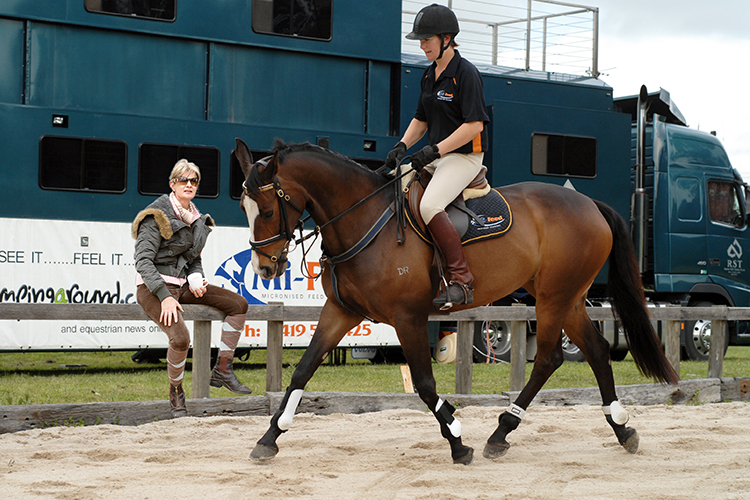 The former head of the Spanish Riding School, Col Alois Podhajsky once wrote a book entitled: ‘My Horses My Teachers’. It’s a concept that showjumping trainer, Michelle Strapp has made good use of in her training program with exciting young showjumping rider, Amy Graham. Michelle has deliberately used different horses, with different levels of education to give Amy that all-important ‘feel’ for how it should be.
The former head of the Spanish Riding School, Col Alois Podhajsky once wrote a book entitled: ‘My Horses My Teachers’. It’s a concept that showjumping trainer, Michelle Strapp has made good use of in her training program with exciting young showjumping rider, Amy Graham. Michelle has deliberately used different horses, with different levels of education to give Amy that all-important ‘feel’ for how it should be.
Amy’s imported jumper, Transatlantic may be the horse in her string that is capable of matching them in a World Cup Qualifier, but it’s her eight year old mare, SE Prada by Damiro, a son of Ramiro, out of a Favoured Bay mare who is helping with feel. Prada started life as Michelle’s dressage prospect, but really wanted to be a showjumping horse, and has been the perfect partner for Amy as she furthers her equestrian education. When Amy sits on Prada she looks like a totally different rider, as Michelle is quick to comment:
“When you ride Charlie (Transatlantic), it looks a bit like you are trying to pedal a bike really fast, you are working hard, you are really busy – why do you think it is different when you are riding this mare? What quality do you have now that you don’t have with the other horse?”
“She’s naturally in front of my leg…”
“She’s more educated in front of the leg. When you jumped Charlie yesterday and you jumped the line and said, that feels awful – what do you think was the weakest link that allowed you to get such sloppy distances?”
“The canter was too weak…”
“Yes, because he wasn’t in front of your leg! That’s what has caught you in practice arenas sometimes, and that’s what has caught you on a turn to a big oxer sometimes, where your eye sees a distance but you don’t actually get to the distance, because he is too far behind you. Why couldn’t you get the bigger stride with Charlie?”
“I had to chase him every stride…”
“Because you felt like you lacked the activity, right. It is very hard to ask a horse to come through and use his whole body if you are having to chase him. We’ve got to get to a stage where you feel that quicker.”
“Yesterday Charlie was lacking his own motivation – he helps you in the ring sometimes because he creates his own motivation… and that is something you have to be prepared to assess when you canter into the ring. At Toowoomba he was really on the job and in front of your leg, but at occasionally at Elysian Fields, he wasn’t.”
“Now when you sit on Prada, you can feel the difference and how easy it is to get down to a distance because she is taking you more. So you have to take that feeling to Charlie so you don’t feel you have to kick him every stride and chase his front legs.”

In the warmup session, Michelle keeps reminding Amy that it is her body that should ‘tell’ the horse what she wants:
“When the trot gets faster if we rise faster that encourages an even faster trot, as our body gets busier it encourages everything to be faster – instead of large, elastic strides. That’s what you’ve got to visualise. If you try to get big elastic strides out of a horse, then your body language on the horse has to do the same thing…”
“This mare has a natural cadence. She marked very well in the Young Dressage Horse class at DWTS, where she is a little hard – and where Charlie is actually easier – is her canter gets over-powerful. She gets quite croup high, and that’s a little the way she is built, I think it was probably a good idea for her to go jumping because I don’t think the high collection work was going to happen.”
So now Amy has a new challenge, improving the mare’s canter, trying to get it straighter, trying to get her to lower her hind end and make the stride bigger:
“Forward and let it swing. Keep the same rhythm, and yes, get her softer to the inside leg, but still keep her forward – so that when you make her move across, she is still in front of your leg. Certainly enlarge the circle and push from inside leg to outside rein, but keep the rhythm. Make sure that left hind leg keeps coming forward to the bridle, otherwise she just cheats – she moves her quarters across but she doesn’t stay in front of your leg.”
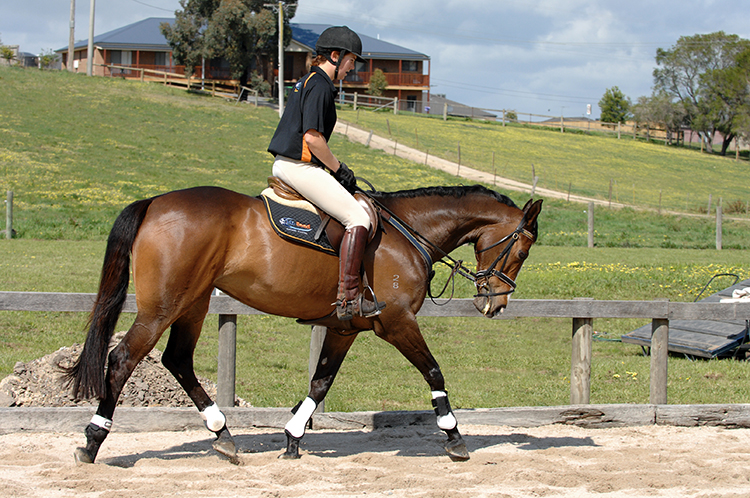
Amy is lucky in that her instructor gets on her horses and can relate to the problems she is having…
“When I rode Amy’s young horse yesterday, I felt he needed to be a lot more in front of my leg, but I bet if Franke Sloothaak sat on one of my horses, he’d probably say that it was not quite enough in front of the leg… When I took Prada to his clinic, Franke said to me, she’s nice, she travels sweet but because she finds it quite easy, it is very easy for her to actually be just sitting behind you.”
“I want you to move into a little shoulder fore on the circle, but make sure she stays in front of that inside leg. I don’t want the rhythm any slower, move her off your inside leg, off your inside leg, and forward to two reins. Good.”
“Did you leave your stirrups at jumping length?”
“Yes.”
“That means you have to canter without your stirrups then. Canter then drop your stirrups, when you feel her hoppy behind, just ride her straight and forward, keep the neck straight, the nose in the centre of the chest. If she feels like she is cutting the corner, don’t correct her just with your inside rein, change her longitudinal balance. Feel like you’re trying to lower her croup and bring her balance back on her hind leg. Good, then forward again, back on the hind leg, and forward again. Don’t stay short too long.”
And, of course, the aim is to improve all the horses in the team – especially Transatlantic: “If Amy can take the feeling from this horse to Charlie, then instead of him jumping off a canter that is a little weak and a little flat, he’s going to have a lot more power.”
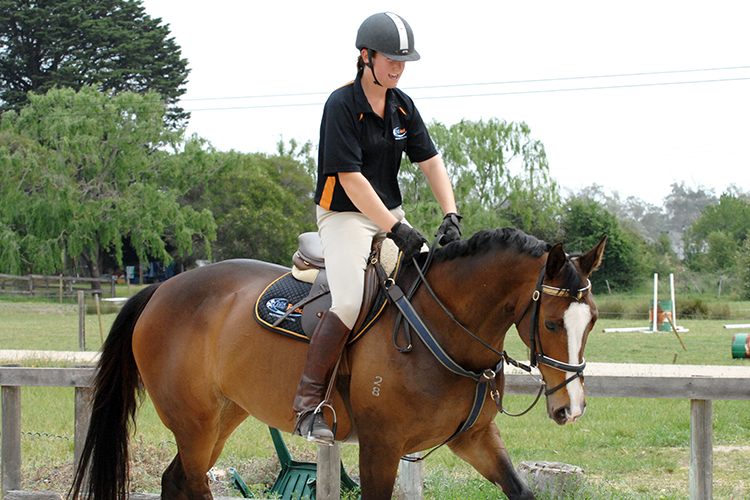
But with Prada, Amy has another problem, to get the mare to sit, to take the weight behind and lower her croup:
“If she starts to get bouncy in the canter, make sure your leg stays back, even though she feels energetic, still keep your leg there, that’s it. You are still riding the hind leg to your hand. What you are trying to do is alter her longitudinal balance. You can’t just pull her short, you can’t just pull the head in. You’ve actually got to feel like you’ve changed her balance, otherwise all that happens is that her nose comes in.”
“As you shorten you’ve got to feel her balance. If you shorten her, think about shortening her with no hands, just think about altering her balance and then relax your hand, see what happens, test her. Relax your elbow, come forward a little for a stride – short release. Shorten your reins so your elbows are ever so slightly in front of your body, now short release again and see if she is carrying herself.”
“You don’t know if she is carrying herself unless you actually soften up. Just give, how much you give depends on how the horse feels like. If you over-give you might lose everything – just a slight give, very good, now go full circle again, and look for self-carriage so she sits on her hind legs and carries herself. Heels down, toe up, don’t let the lower part of your leg get sloppy, bring your leg back.”
“When you change rein, think about the crookedness this way. She’s much straighter today, yesterday she was on permanent two tracks, travers right, and the mare uses that as a cheat, rather than bring her balance back. Just try and keep it so her hind legs follow her front legs, so she has to keep her balance back on her hind leg. Relax your arm, very good, she’s dying to swing those quarters at you instead of bringing her weight back.”
“Now go out of the small circle onto a big circle. Heels down, toes up – gradually let her down into a longer frame without her running. Your body still says ‘half halt’, your body still says ‘wait’. Do it inch by inch with your reins, don’t suddenly drop them, feel it, feel the balance – you’ve got to balance her now, not from your reins but from feeling your longitudinal balance. Then soft again, then half halt again, soft again. Follow her mouth for half a stride, relax, put your hand forward, now half halt again – that’s better. Then give again.”
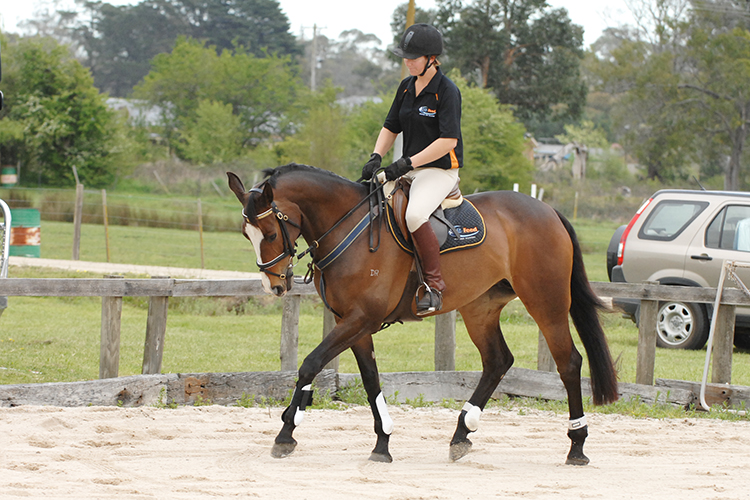
“A jumping horse should be able to work in any frame you want, so that they are starting to use all their body. What you want them to do in mid-air over a big oxer is to use their neck. So if we can’t canter just allowing them to stretch and use their neck, it makes it very hard for them to be able to do it in mid-air. She’s getting much straighter, now try to give again, it doesn’t matter if it’s not perfect, give again, and if she falls in a heap then you know what has gone wrong. Heels down, toes up, give again.”
“It’s a lot easier when you are trying to make a horse take more rein, if you don’t let your reins get too long – because then if she starts to run, you have to be too busy with your hand. Shorten your reins, and give from your elbow – give again. Better – that’s the idea. A half halt with your position, and give again. Two reins forward, up the neck, let them go – that’s it. Half halt again, your reins have got long again, now give again. Follow, there you go, good.”
Okay, now try it in trot, try to get her to stretch and lengthen without losing her balance:
“Follow the mouth and if she feels like she is falling down, do a half halt by slowing your rise down, good, you dictate the rhythm. Dictate it by the way you rise. If you are rising fast, she’ll run and fall out of balance. Half halt with your position, slow your rise. Okay let’s have a walk then we’ll give her a jump.”
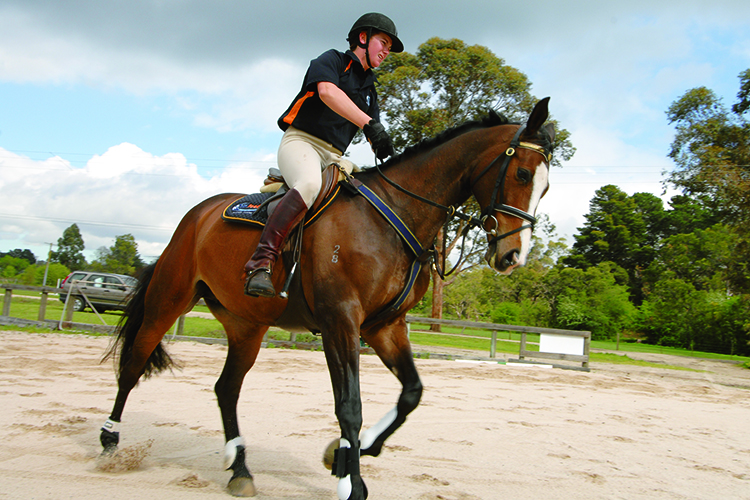 AMY
AMY
When did you start riding Prada?
“Back at Easter time last year. I had one ride on her when I first met Michelle. Michelle was training her at the time, and she said jump on, because she wanted to have a look at her over a jump. I was based here for a little while, and Michelle taught me on her every day – then we took her to the show at Mt Gambier, and that’s when we purchased her and I started riding her.”
What is she like to ride?
“She’s beautiful, because she is so well educated she gives me a feel of what I am trying to achieve on all the rest of my horses. If you don’t have a horse like her, then you are not sure of where to go, you know you want to educate your horses, but you are not sure to what level – or what it is supposed to feel like. She is not easy because she has so much power that it can be difficult trying to get her to sit on her hocks, but she does do it if I work at it. She has such a god mind as well.”
What got you into jumping riding?
“I started riding at six, Pony Club at around seven or eight. Then I had to choose between netball and pony club, I chose pony club – and then I had to choose which discipline. I decided jumping because mum and dad had done jumpning – but i also thought it was better because if you got eliminated there was always the next class, but if you got eliminating eventing, that was it for the weekend.”
“I didn’t mind dressage, didn’t mind flat work back then, but I guess mum and dad were keen on jumping.”
Who were your first trainers?
“My grandmother was first. Mum and dad never wanted me to ride. When I was about eight or nine, my grandmother bought mt first two ponies and broke them in with me. Finally mum and dad gave in, and they started travelling around with me.”
“Obviously I had pony club coaches, various coaches through the years, especially when I got on the State Squad. Alexa Bell, Jamie Coman a little bit – no one major until Michelle. I was overseas in Ireland, that’s when I found Charlie and I had dressage lessons there, that was my first real flat work lessons. That was with Niall Quirk. The state coaches were basically jumping lessons, not so much on the flat… He was okay, he got me started on Charlie then I came home and found Michelle.”
